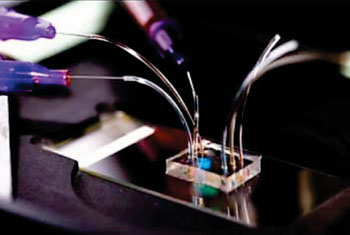Neutrophil Motility Reveals Potential Sepsis Biomarker
By LabMedica International staff writers
Posted on 22 Dec 2014
The development of sepsis in patients with major burns may be predicted by abnormal motility patterns of white blood cells called neutrophils, measured through the microscopic channels of a novel device.Posted on 22 Dec 2014
Since the symptoms of sepsis are similar to those of the systemic inflammation that occurs in almost every serious burn patient, diagnosing sepsis relies on culturing bacteria from the blood, a process that takes 12 to 24 hours.

Image: The microfluidic device for ascertaining neutrophil motility patterns (Photo courtesy of the BioMEMS Resource Center, Massachusetts General Hospital).
Scientists and bioengineers at the Massachusetts General Hospital (Boston, MA, USA) took blood samples from patients with large thermal injuries admitted to the Massachusetts General Hospital (MGH). Enrolment criteria included burns covering at least 20% of total body surface area, age between 18 and 81, and included in the enrollment were both male and female, proportionally distributed among ethnic groups.
Neutrophils were isolated from whole blood by density gradient using the EasySep Human Neutrophil Kit (STEMCELL Technologies Inc.; Vancouver, BC, Canada). A microfluidic devise was assembled to generate chemical gradients in two simple steps performed at the beginning of the study, after which the device does not require any user intervention or external syringe pumps to operate. The microfluidic devices was made with two layers of photoresist SU8 (Microchem; Newton, MA, USA), the first one 3 µm thin and the second one 50 µm thick, were patterned on one silicon wafer by sequentially employing two photolithography masks and processing cycles. The wafer with patterned photoresist was used as a mold to produce polydimethylsiloxane parts, which were then bonded irreversibly to standard glass slides.
The team analyzed the ability of neutrophils from blood samples of 13 patients with serious burns, collected several times during their treatment, to move through the device when it was primed with one of two chemical attractants or with saline solution, and compared it with the movement of cells from three healthy volunteers. Neutrophils from healthy individuals moved quickly and efficiently through the device toward a chemical attractant, easily navigating around corners and posts, while cells from burn patients showed limited, slower and poorly organized movement toward the chemical signal. This movement of neutrophils in the absence of chemical signals was observed in samples taken from some patients several days before a diagnosis of sepsis could be made, and once effective antibiotic treatment began, the unusual movement pattern began to fade.
Daniel Irimia, MD, PhD, a leading author of the study said, “Since only a handful of rare genetic disorders affect neutrophil function, it has long been assumed that studying these cells was not important; but our findings indicate that neutrophils play a much more important role in sepsis than has been appreciated. We're also working to expand this investigation to other patients at risk for sepsis, to see if the findings from burn patients have broader application.” The study was published on December 9, 2014, in the journal Public Library of Science ONE.
Massachusetts General Hospital
STEMCELL Technologies Inc.
Microchem
Related Links:













